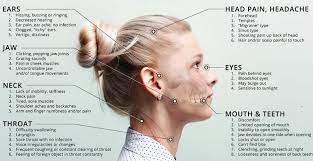This condition may be accompanied by pain and a crackling sound in the ears called crepitus. This noise results from damaged cartilage and bone rubbing together in the jaw joint.
These joints connect your jawbone to the skull and act as a sliding hinge whenever you speak, chew, or swallow. Fortunately, there are several ways to get rid of ear fullness that stems from TMJ disorders.
- Relax Your Jaw
Many people clench their jaws without realizing it, which can cause the muscles to become tight and lead to pain. Often, this clenching is caused by stress or anxiety. Practicing relaxation techniques or seeking counseling can help alleviate stress and reduce the clenching, which can improve jaw muscle soreness and relieve ear fullness.
Other ways to relax the jaw include eating soft foods and avoiding chewing gum or hard, crunchy food. Taking a break from these foods can allow the muscles to rest, which is an important part of the treatment for TMJ. It is also a good idea to use a hot or cold compress on the jaw for comfort.
There are also exercises that can be done to strengthen the jaw muscles, including resisted opening and closing. To perform these, place your thumb under your chin and push downward for resistance while slowly opening your mouth. Then, close your mouth while keeping the thumb against your chin for resistance. Repeat this exercise 6-10 times each day.
Another simple jaw exercise involves placing your tongue on the roof of your mouth, with one finger in front of your ear where your TMJ is located and your pointer finger on your chin. Drop your lower jaw halfway and close it, which should feel mild resistance but not pain.
- Change Your Diet
TMJ can cause ear fullness, along with a range of other symptoms, including jaw pain, difficulty chewing and swallowing, ringing in the ears and clicking or popping noises when you open your mouth or move your jaw. You can alleviate the discomfort by changing your diet to include soft, easy-to-chew foods.
Avoid fatty foods like butter and margarine, as well as processed foods with high salt content and fried items that require heavy chewing. Eat fresh vegetables, lean protein (like chicken or fish) and whole grains such as quinoa, brown rice, couscous and polenta. Cooked or steamed vegetables are a good option, as are salads made with leafy greens and topped with tomatoes, cucumbers and pickles. Fruits that are easy to eat without chewing are also a good choice, such as bananas, berries and peaches.
Ear fullness is a symptom of TMJ that happens when the Eustachian tube, which connects the middle ear to the back of the throat, becomes inflamed or blocked due to TMJ. The pressure of the swelling pulls on the eardrum and creates a sensation of fullness in your ear.
To avoid this problem, eat a diet that is low in fat and avoid foods that require a lot of chewing, such as crusty breads, bagels, pizza crusts, hard cookies and beef jerky. A diet that focuses on pureed or mashed foods is more TMJ friendly.
- Perform Jaw Exercises
Performing jaw exercises can help strengthen the muscles that are responsible for chewing. They can also help to stretch the muscles in the neck and jaw that are often tight from clenching or gritting the teeth. These exercises can include chin tucks, opening and closing the mouth, side to side movement of the jaw, and other jawline and neck stretches. These exercises should not cause pain or discomfort and should be done slowly to avoid strain.
One exercise is to look in a mirror and bite your teeth together, then slowly open your mouth as wide as you can. Repeat this ten times. Another is to place your thumb underneath your chin, and then use the index finger from the same hand to push downward on your chin to create resistance. Close your mouth as far as you can, then gently open it again. Repeat these exercises ten times each.
For a more advanced exercise, place an object, such as a pencil or the end of a ruler between your top and bottom front teeth. Clench the item and then move your lower jaw forward so that it is in front of your upper teeth. This is a good way to work the muscles in your jaw and to stretch the ligaments. You can also massage the area to increase blood flow and reduce muscle tension.
- See Your Dentist
The temporomandibular joint (TMJ) is the hinge that connects the jaw to the temporal bones of the skull, right in front of each ear. It lets you move your jaw up and down and side to side so you can talk, chew, yawn, and swallow. But problems with your TMJ can cause pain, tenderness, and stiffness in and around your ear. These problems are usually called TMD (temporomandibular disorder) or a TMJ problem.
TMJ-related ear fullness can feel like an ear infection or sinus pressure. Typically, the ear fullness is caused by TMJ dysfunction, which causes the Eustachian tube to fail to open and close correctly. The resulting pressure in the middle ear can give the sensation of a crunching sound, similar to what you may experience on a plane flight.
If you think you have a TMJ-related ear fullness, it’s important to see your dentist for an examination. They’ll take a detailed medical history and check your jaw, teeth, and TMJ for signs of the condition. They’ll also do a physical examination, which includes feeling for tight muscles and checking the flexibility of your joints. They might recommend X-rays of your face and jaw, an MRI, or a CT scan to get more information about the problem. They’ll then create a treatment plan to help you manage your TMJ symptoms, including ear fullness.

